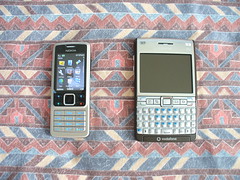 Image by osde8info via Flickr
Image by osde8info via Flickr
The real father of the mobile phones is considered to be the Motorola researcher Martin Cooper who invented the first handheld device for mobile communication independent from a vehicle setting. The first cellular network ever launched in a city was NTT in Japan, as early as 1979. Only in the mid-eighties were the first automatic networks introduced, this time in Norway, Sweden, Denmark and Finland. The popular technology of wireless phones has undergone massive changes since then, with great boosts of growth in the technological and cellular systems they rely on.
The 90s brought the first serious competition between service providers for wireless phones, just after the GSM standard became widely used. It took very little to pass from SMS messaging to conversations, and ever since, cellulars have outrun all other means of communication. To understand the ample exposure of the phenomenon, it suffices to refer to the camera sales drop that appeared after the invention of the built-in cell high quality cameras that allow picture taking in great resolution format and at the same superior technical standards.
The Internet and the evolution of the mobile phones ran in parallel for a while before overlapping, and since then they have remained inseparable. This is how we got to enjoy the modern facilities such as email, fax, web browsing and even online video watching on the mobile. Digital technology also heavily contributed to the development of sophisticated batteries and the miniaturization of all the cellphone components. With all the incredible level of complexity things have reached today, one has to wonder where the road is taking us further. Will we try to make things simple again or further relish.
![Reblog this post [with Zemanta]](http://img.zemanta.com/reblog_e.png?x-id=ce7cdd45-d17d-45b6-a631-b05b023069fa)
No comments:
Post a Comment